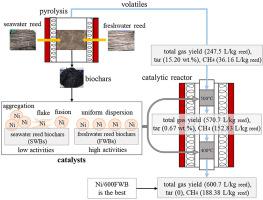Biomass & Bioenergy ( IF 6 ) Pub Date : 2021-09-25 , DOI: 10.1016/j.biombioe.2021.106250 Xia Yue 1, 2 , Dezhen Chen 1 , Jia Luo 1 , Zhen Huang 3 , Liu Hong 1 , Yuyan Hu 1

|
Thermochemical conversion of biomass into methane is a promising way for bioenergy recovery and alleviate natural gas shortage; however, the available technologies are queried by the complex procedures. This paper proposed a new approach for the direct synthesis of methane-rich gases from reed pyrolysis volatile at atmospheric pressure, according to which the reed pyrolysis volatiles are catalyzed over reed biochar-supported Ni catalysts in two stages to be converted. Seawater and freshwater reeds were compared for preparing effective catalysts, and the influences of inorganic salts in reed biomass on the catalytic performance were explored. The reed biochar-supported Ni catalysts were also compared with γ-Al2O3-supported Ni catalyst (Ni/γ-Al2O3) to evaluate their activities. It has been found that freshwater reed biochar-supported Ni catalysts (Ni/FWBs) performed better than seawater reed biochar-supported catalysts (Ni/SWBs) and Ni/γ-Al2O3 owing to their large specific surface areas, uniform Ni particle dispersions, and appropriate Ni/biochar interactions. The Ni/FWB with biochar support produced at 600 °C (Ni/600FWB) was the best, and its corresponded tar-free gas product was characterized by a methane yield of 188.38 L/kg reed after two-stage catalytic conversion. The SWBs with higher alkali metal contents corresponded to larger Ni loading amounts than that of FWBs under the same conditions; however, they suffered from Ni particle aggregation and fusion, which deteriorated their catalytic activities. The findings indicated that the inexpensive Ni/FWBs were effective for the direct synthesis of methane from biomass pyrolysis volatiles, and the approach developed in this study provides an alternative to produce methane from biomass economically.
中文翻译:

芦苇生物质热解挥发物在其生物炭负载镍催化剂上直接合成富含甲烷的气体
生物质热化学转化为甲烷是生物能源回收和缓解天然气短缺的一种有前景的途径;然而,可用的技术被复杂的程序所质疑。本文提出了一种在常压下由芦苇热解挥发物直接合成富甲烷气体的新方法,根据该方法,芦苇热解挥发物在芦苇生物炭负载的镍催化剂上分两阶段催化转化。对比海水和淡水芦苇制备有效催化剂,探讨了芦苇生物质中无机盐对催化性能的影响。芦苇生物炭负载的 Ni 催化剂也与 γ-Al 2 O 3负载的 Ni 催化剂(Ni/γ-Al 2 O 3) 来评估他们的活动。研究发现,淡水芦苇生物炭负载 Ni 催化剂 (Ni/FWBs) 比海水芦苇生物炭负载催化剂 (Ni/SWBs) 和 Ni/γ-Al 2 O 3表现更好,因为它们具有较大的比表面积、均匀的 Ni颗粒分散体,以及适当的 Ni/biochar 相互作用。在 600 °C (Ni/600FWB) 下生产的带有生物炭载体的 Ni/FWB 是最好的,其对应的无焦油气体产品的特征是甲烷产量为 188.38 L/kg芦苇经过两阶段催化转化。在相同条件下,具有较高碱金属含量的 SWBs 对应的 Ni 负载量高于 FWBs;然而,它们遭受了 Ni 颗粒聚集和融合,从而降低了它们的催化活性。研究结果表明,廉价的 Ni/FWB 可有效地从生物质热解挥发物直接合成甲烷,本研究中开发的方法提供了一种从生物质经济地生产甲烷的替代方法。



























 京公网安备 11010802027423号
京公网安备 11010802027423号